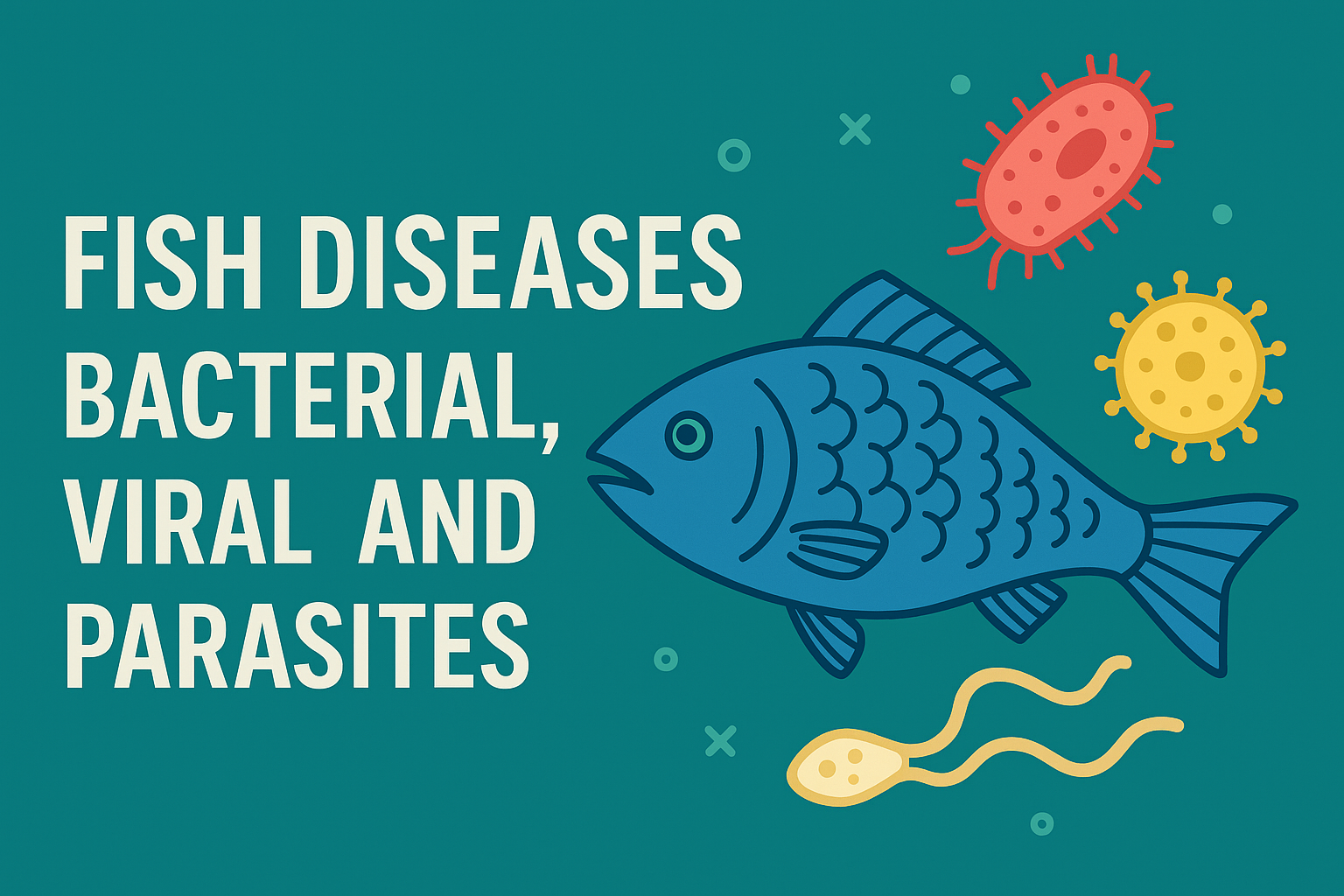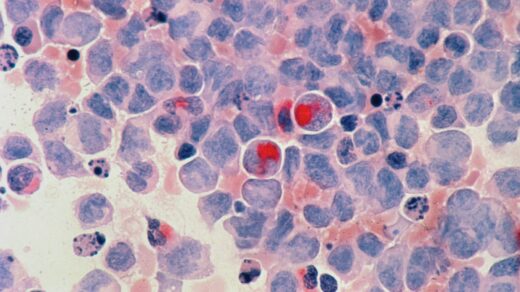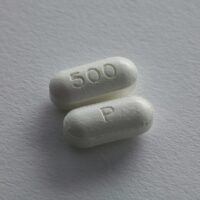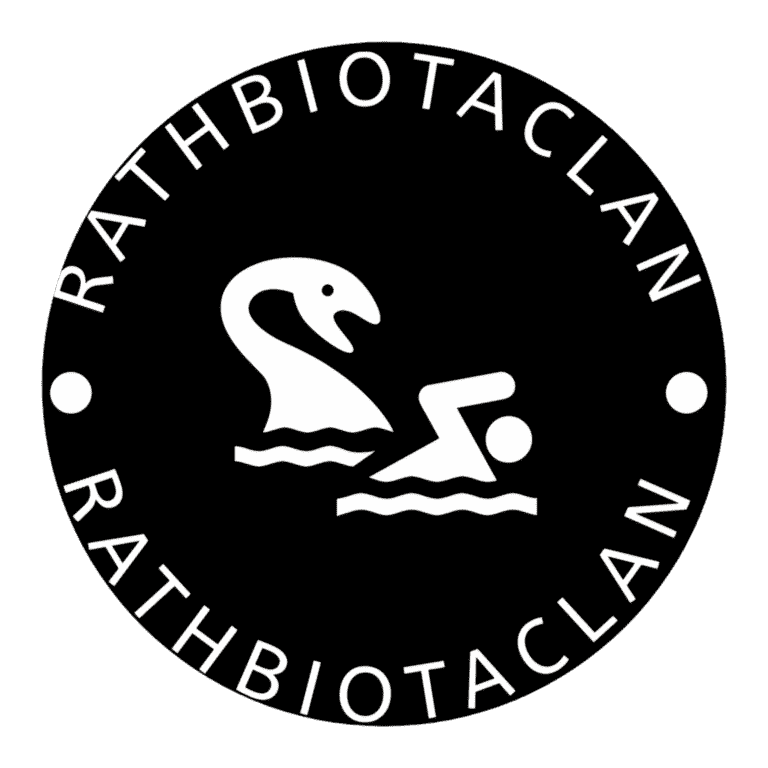Fish diseases: bacterial, viral and parasites pose a critical challenge in aquaculture, affecting both freshwater and marine species. These diseases, which include bacterial infections like dropsy and columnaris, viral conditions such as VHS and IPN, and parasitic infestations by protozoans and helminths, often lead to severe economic losses. Due to the lack of effective treatments for many of these illnesses, early detection and preventive strategies remain the cornerstone of disease management in aquaculture.
1. Bacterial Diseases
These bacterial infections are, frankly, a big worry because they can cause heavy losses to fish farms. They’re found everywhere, in both tropical and temperate aquaculture. Sometimes, they even pop up as secondary infections right alongside viral diseases.
Here are some of the common bacterial culprits:
Dropsy
This one, specifically abdominal dropsy in carps, is caused by Aeromonas punctata. You’ll typically see it in temperate regions during spring.
What’s it look like?
Well, the fish will have fluid accumulating inside its body cavity, fins that are sort of withering away, scales sticking out (protrusion), and just a general puffiness or edema. Internally, the intestines are inflamed, and the liver and kidney get hit too. The bacterium itself is a rod-shaped little thing, with a flagellum, measuring about 1 to 1.5 mm. Interestingly, if the fish is in good health, the bacteria can stay dormant, just hanging out. It’s the weaker fish that really get affected, and unfortunately, this can lead to death. The disease spreads when that fluid, packed with bacteria, leaks out of an infected fish after it dies and starts to decay.
Furunculosis
Now, furunculosis is caused by Aeromonas salminicida. This disease has a cosmopolitan distribution, meaning it’s found all over the world, and it can infect lots of different warm-water and cold-water fishes. But it’s primarily a problem for salmonids, like Salmo salar, S. fario, S. salvelinus, and S. irridaeus. The bacterium is also rod-shaped, but a bit smaller, around 2 to 3 μm. The name “furunculosis” comes from the blisters, or furuncles, that appear on the infected fish’s skin. These furuncles are like rounded boils on the sides of the body, filled with pus—which is basically a messy mix of destroyed body tissues (muscles, white blood cells, etc.) and bacteria. Sometimes, these swellings burst, releasing their contents into the water. In really bad cases, we’re talking massive infection, the intestines get super inflamed, and that inflammation can spread to the peritoneum and muscles. This often leads to mass mortality, which has been seen in trouts, for example.
Columnaris
Then there’s Columnaris, caused by Flexibacter columnaris. This one shows up as a chronic form in both cold-water and warm-water fishes globally. Fish that are under stress, maybe from being overcrowded or from increased water temperatures, are really susceptible to it. There are two main strains identified: one with high virulence and one with low virulence. The less virulent form usually causes cutaneous infection, like problems on the skin. You’d see discolored grey patches on the dorsal fin, which then grow and expose the underlying muscle tissue. These lesions are quite prominent around the mouth and head, and can later turn yellow and become cratered. The highly virulent strain, though, is much more aggressive; it attacks the gill tissues, leading to a nasty “gill rot” condition.
Gill Rot (Bacterial)
Separate from Columnaris-induced gill rot, there’s another “gill rot” primarily affecting grass carp fingerlings, caused by Myxococcus piscicola. It’s characterized by masses of myxo-bacteria on the gills and is linked to hyperplasia of the gill epithelium. In acute infections, the gill covers become inflamed and get eroded by the bacteria, leaving behind small, transparent patches.
Vibriosis
Vibriosis, caused by Vibrio anguillarium, is a seriously significant disease, hitting both salt and fresh waters. It’s become one of the most severe diseases for cultivated marine fish species like rainbow trout and salmon. This bacterium typically gets into the fish through surface wounds and mainly impacts the skin, causing lesions. In acute cases, these ulcers can go deep into the muscles, and you might see internal bleeding (haemorrhage), kidney damage, and a swollen spleen. Shrimps, including larvae, juveniles, and adults, can also get infected. For them, the bacterial attack might result in septicemia, and common signs include disoriented swimming and the abdominal muscles becoming increasingly opaque in juveniles and adults. Ultimately, it can wipe out an entire stock.
Fin and Tail Rot
Finally, for bacterial diseases, we have fin and tail rot, caused by Pseudomonas. The margins of the fins become necrotic, and they actually slough away. This disease often happens when environmental conditions are unfavorable. The good news is that improving the water quality in the ponds can often lead to a cure.
2. Fungal Diseases
Fungal diseases are super common, especially in freshwater environments. Some fungi are primary invaders, but most are saprophytic opportunists. This means they seize opportunities, often taking advantage of:
- Necrotic tissue from injuries
- Bacterial or parasitic lesions already present
- Dead and decaying eggs
- Unsanitary conditions
Here are a couple of key fungal diseases:
Saprolegniasis (Cotton-wool disease)
This one is caused by Saprolegnia and some other non-saprolegniaceous fungi like Pythium and Leptomitus. It impacts the skin and, in later stages, the gills of freshwater fish and crustaceans. You’ll see small white tufts appearing on the skin and fins. They’re pretty distinctive, looking like profusely branched, non-septate, cotton-wool-like tufts of mycelium.
Branchiomycosis
Also known as gill rot of carps, Branchiomycosis involves the fungus Branchiomyces attacking the gills of carps and channel catfishes, usually in the summer. When the infection starts, the fish’s gills show deep red patches. As it progresses, necrosis sets in, and the gills change color to a yellowish brown. It’s quite common for a secondary Saprolegnia infection to happen at this point, too.
3. Viral Diseases
Viral diseases are another major concern, often with no known cure, making prevention the best defense.
Let’s look at some of the significant viral diseases:
Infectious Pancreatic Necrosis (IPN)
IPN is a really important viral disease that infects trout and salmon, though the virus has also been found in other fish species like eels, and even in several types of bivalve molluscs. The virus is a birnavirus, measuring about 70 nm. It’s an acute disease in fry and fingerlings, and outbreaks can be triggered by poor husbandry, unfavorable environmental conditions, and overstocking. Affected fish show weak respiration and often exhibit convulsive movements. They might also have a pale overall pigmentation, bulging eyes (exophthalmia), a distended abdomen, and hemorrhages on their ventral surface. Bleeding can also be seen in the pyloric caecae, and their liver and spleen might turn pale. A very distinctive sign of IPN is the presence of clear or milky mucus in the stomach and anterior intestine. When mortality rates are high, infected fish often swim in a peculiar whirling manner around their long axis. This whirling is a terminal sign, meaning the fish usually dies within an hour or two. A critical point here is that most survivors become lifelong carriers of this virus, intermittently shedding it for a long time through urine, feces, milt, and eggs. The virus can even be transmitted from parents to offspring through the eggs.
Viral Hemorrhagic Septicemia (VHS)
VHS is economically the most important viral disease for cultured salmonids, especially rainbow trout raised in hatcheries. It’s caused by a bullet-shaped rhabdovirus, about 50 nm in diameter. The disease spreads through direct contact, during transportation, from poor handling, and from fish to fish via water. Interestingly, a rise in water temperature tends to lead to fewer losses, and the losses actually stop during spring. Symptoms of VHS include general anemia, pale gills, swollen eyes and belly, muscle edema, and inflamed intestines. You might also see sores on the skin, a protruded anus, and often affected kidneys and liver. Bleeding occurs in the gills and muscles, and fish might show signs of excitability, including erratic swimming.
Infectious Hematopoietic Necrosis (IHN)
IHN is another acute viral disease, caused by a bullet-shaped virus, affecting the fry and fingerlings of salmons and trouts. It spreads from fish to fish and from parent to progeny through seminal fluids or infected eggs. Mortality can occur from the sac fry stage all the way up to the yearling stage. The symptoms include weakness, a dark coloration, abdominal swelling, and pale gills. The kidney gets affected, often becoming translucent and speckled with pigment cells.
Infectious Dropsy of Carp (IDC) and Spring Viremia of Carp (SVC)
Now, Infectious Dropsy of Carp is considered the most serious disease for common carp and several other fish. What’s tricky is that IDC isn’t just one thing; it actually encompasses several etiologically different diseases like Spring Viremia of Carp (SVC), carp erythrodermatitis, swim bladder inflammation, pseudomonas septicaemia, and aeromonas septicaemia. And, of course, the treatments and prevention methods for each of these vary. SVC itself is caused by a rhabdovirus and is very contagious, capable of causing high mortality. The symptoms are quite broad: reduced movements and frequent resting, darkening of the skin, protruding eyes, bleeding from the eyes, fins, skin, and gills, fecal casts trailing from a reddish, protruding anus, fluid accumulation in the abdomen, inflamed intestines, internal organ bleeding, and anemia. This rhabdovirus is transmitted from brood fish to their offspring through eggs or sperm, and it enters the fish primarily through the gills.
Channel Catfish Virus (CCV)
CCV is a serious viral disease, caused by a herpesvirus that’s about 100 nm in size. It affects fry and fingerlings of channel catfishes, usually those less than 4 months old, in culture mediums. Affected fish tend to hang vertically in the water and show a loss of balance, often swimming in spirals. Lesions develop at the posterior part of the kidney, with an increased number of lymphoid cells. These lesions can later spread to the liver, spleen, and the digestive tract. You’ll also see hemorrhages in the muscles, gills, skin, and at the fin bases.
Carp Pox (CP)
In cyprinids, carp pox is caused by a virus that’s similar to herpesvirus. The disease is marked by proliferation of the skin, basically a cutaneous growth, which unfortunately reduces the marketability of the fish. However, it’s worth noting that this disease seldom causes any mortality in the infected fish. Interestingly, Argulus, also known as the carp louse, actually acts as a virus-carrier, transmitting the virus within a pond population.
Lymphocystis
Lymphocystis is a viral disease that appears as whitish nodules on the fins, head, and sometimes even the whole body of the fish. It’s found in various species of freshwater, brackish water, and marine fish. In culture conditions, it’s highly contagious and spreads really rapidly.
4. Parasitic Diseases
Parasitic diseases are a big deal too, with various protozoan parasites living on fish and other aquatic organisms. They can cause both external and internal diseases, often creating havoc in hatcheries and rearing tanks. Sometimes, infected fish might even die without showing any symptoms, which makes it tricky to catch early.
Let’s break down the different types of parasites:
A. Protozoan Diseases
- Ichtyobodosis (formerly Costiasis)
This one is pretty common among fish that have been farmed for long periods in crowded conditions, affecting species like common carp and trout. The cause is a flagellate called Ichtyobodo necator (or Costia necatrix). The parasite attaches itself to the host’s skin, using finger-shaped processes at the attachment point. It multiplies asexually through longitudinal fission. If it falls off the host’s body, it dies. Water acts as the medium for transmission, and this parasite is quite robust, able to tolerate temperatures from 2°C to 30°C. The main symptom is a slimy secretion on the skin, fins, and gills. Dull spots will appear on the sides, which then merge into a continuous greyish film. In advanced stages, red patches might show up, and fins can become folded with tissue erosion between the rays. Infected gills become pale and partially destroyed. If it’s not checked, this infection can become quite dangerous.
- Ichthyophthiriasis (White Spot Itch Disease)
Popularly known as white spot itch disease, this is caused by a ciliate, Ichthyophthirius multifiliis, and it’s pretty widespread, affecting all species cultured in ponds, including common carp and trout. The parasite is about 0.5-1.0 mm long, with a round or ovoid body covered in longitudinal rows of cilia. Since it can handle a wide range of temperatures (25°C to 26°C), outbreaks usually occur in spring and summer when the water is warmer. The classic symptom is the appearance of numerous small white specks (early infection) or larger white spots (advanced infection) over the entire body. These spots are actually small chambers where the parasites have accumulated. Mature parasites will leave the fish periodically, which is how the disease spreads. Epidemics can break out, leading to mass mortality, especially when the fish are weakened and their resistance is low.
- Knot and Boil Disease
Caused by various species of Myxobolus, this disease results in ulceration that looks like a boil, a knot, or even rice-shaped. You’ll see it on the skin of common carp (Cyprinus carpio), and on the gills and other body parts of tench (Tinea) and barbels (Barbus).
- Whirling Disease
The protozoan Myxosoma cerebralis causes this aptly named whirling disease, which is particularly prevalent among salmonids. The key sign here is a rapid tail-chasing behavior, especially when the fish is frightened or trying to feed. The parasite feeds on the cartilage of young host fish. In advanced stages of infection, you’ll see skeletal deformation, including deformed skulls and gill covers, and a curved spine. In the early stages, trout might even develop ‘black tail’. The infection spreads through infected fish, contaminated water, and mud. A really concerning fact is that the spores of Myxosoma can survive for 10-15 years in contaminated mud. Talk about persistent!
- Copepod Infection (Ectoparasites)
The copepod parasites are ectoparasites, meaning they live on the outside of the fish, and belong to families like Arguilidae, Ergasilidae, and Lernaeidae. They generally infect several cultivable fish species, with Argulus foliaceus and Lernaea cyprinacea being the most well-known.
- Fish Lice (Argulosis)
Infection by fish lice is one of the most common issues, caused by various Argulus species, such as A. foliaceus, A. coregoni, A. japonics, and A. giordanii. Outbreaks of argulosis are often fatal, leading to mass mortality. The parasite itself is pretty large; adult males are about 4-5 mm, and females are even bigger at 6-7 mm. They’re oval with a flattened, greyish-green body, and they have large suckers and a proboscis that they use to cling on and suck blood from the host’s body surface. Common victims include carps, trouts, tench, pike, bream, and eels. Affected fish show red blotches on their skin and will make frantic efforts to dislodge the parasite, like frequent scratching. You can really see signs of nervousness in their behavior.
- Anchor Worm Disease (Lernaeosis)
Better known as Lernaeosis, this disease is caused by species of Lernaea, such as L. cyprinacea and L. ctenopharyngodonis. This infection has been observed in a good number of freshwater fish. The mature females of these anchor worms have a long, unsegmented body. Their head has branched processes that help the parasite penetrate the host’s body. What’s interesting is that this worm doesn’t need an intermediate host; its free-living larva can parasitize any species of fish. However, these worms are very sensitive to salinity and can only survive in low salt concentrations.
B. Worm Infections
There are four main groups of worms that are parasitic on fish: flatworms (trematodes), tapeworms (cestodes), roundworms (nematodes), and thorny-headed worms (acanthocephalaus), plus fish leeches.
- Flatworm Infection
These infections are typically caused by flatworms, or trematodes, like Distomum and Dactylogyrus. They attack the gills, causing swelling and a marginal discoloration. Their life cycle is a bit more involved, requiring two intermediate molluscan hosts to complete.
- Tapeworm Infection
Caused by the tapeworm Ligula intestinalis, this parasite can get quite large, reaching lengths of 15 to 40 cm. You’ll actually see this infection more commonly in wild fishes than in cultivated ones. Fish infected with this parasite will show a swelling of the belly. The gonads are negatively affected, leading to a loss of fertility, and in some cases, death can occur. The parasites reach their adulthood in fish-eating water-birds, where they harbor.
- Fish Leech Infection
Fish leech infection is caused by leeches from the families Rhyncobdellidae and Gnathobdellidae. Smaller fishes tend to be more affected. The infected fish appear restless and make desperate, though often futile, efforts to get rid of the parasites.
Conclusion
So, there you have it – a detailed rundown of the common bacterial, viral, and parasitic diseases that can plague farmed aquatic organisms. It really drives home the point that keeping an eye on water quality, managing stocking densities, and overall good husbandry are just crucial for preventing these widespread and often devastating issues.
REFERENCES
- Fish and Fisheries – B. N. Yadav
- A Textbook of Fish Biology and Fisheries – S. S. Khanna & H. R. Singh
- Introduction to Fishery Science – B. K. Tiwari & S. C. Pathak

















